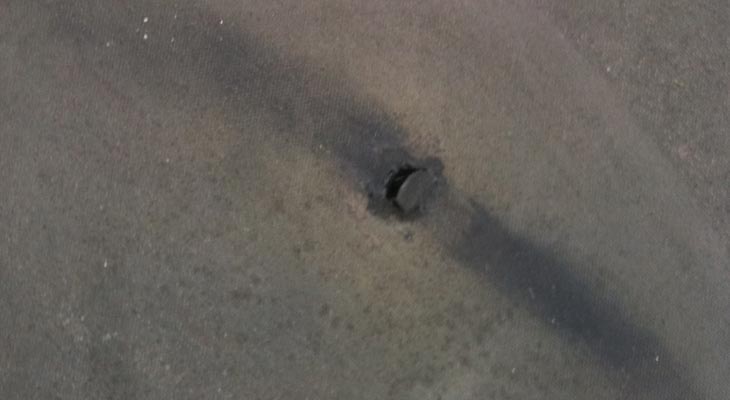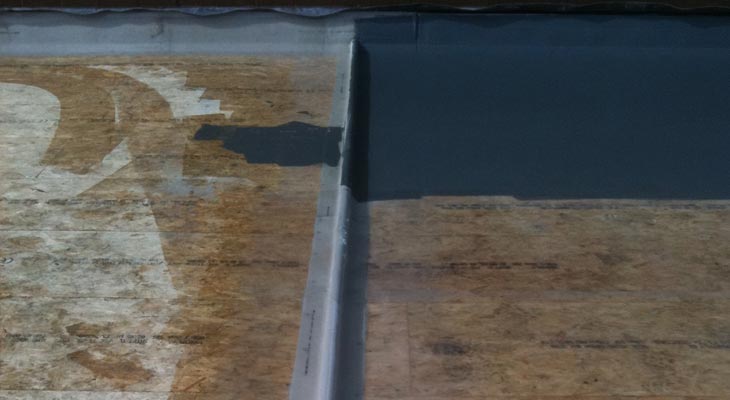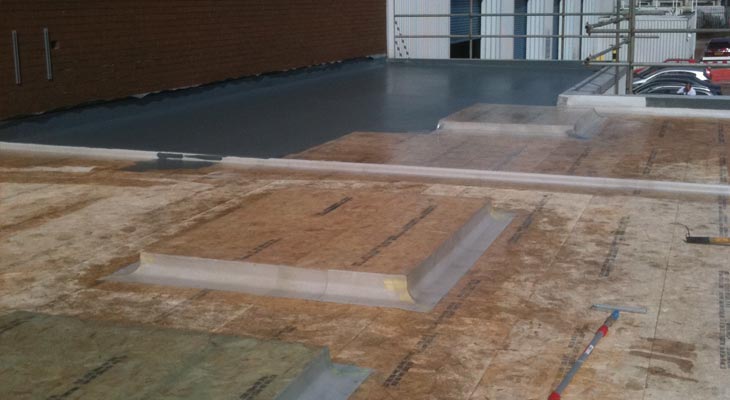GRP FLAT ROOFING IN OLDBURY
Coverclad Services were tasked to install GRP flat roofing in Oldbury to offices that join onto a factory. The rubber membranes that formed the existing two flat roofs had delaminated and de-bonded from the substrates, causing several leaks into the buildings below.
Our job description was to patch, prepare and clean the existing roofs, and to remove folds of rubber membrane where needed, then to install GRP flat roofing throughout the 100+ square metre areas (including over several unused rooflights), with associated expansion trims and upstands. Overall the job took nearly four weeks to complete with inclement weather.
Photos from the GRP flat roofing in Oldbury are below. If you require more information on our GRP services please telephone 01384 573088. If you are in need of an emergency callout then please telephone 07976 726770. Alternatively you can send us a message.

Before view showing the existing flat roof rubber membrane, blown with roll effects in a state of disrepair. When installing rubber roofing an adhesive is used, but solar degradation tends to break down the adhesive over time, which causes the blowing effect underneath.

Before view showing a severe slumping effect and water ingress point to the rubber membrane upstand, potentially caused as a result of the parapet capping being lifted at some point in the past.

One of our Coverclad GRP roofing experts in Oldbury, beginning work on one of the outlet fixing points to the rubber roof, with debris and icy water collecting in the cold conditions.

Close-up showing one of many splits and tears to the rubber membrane. Freeze fall expansion causes these splits and tears to get worse over time, eventually leading to water ingress points.

Close-up of a rooflight corner previously rubber sheeted over. The joins become weak points, leading to slumping, stress lines and cracking.

One of numerous instances of historic patch repairs across the roof, in this example a cold applied liquid membrane together with felt patch to bridge the split gap.

Before view showing a broken down and failing historic repair to a parapet capping joint.

Progress view of the rubber membrane after cleaning, see the wave effect from the delamination of the rubber sheeting from the substrate of the roof.

Progress view of the GRP roofing in Oldbury. Marine ply boards and trims installed to both the flat roof areas and the old protruding rooflights (the rooflights were already unused and sheeted over with rubber roofing prior to us starting). Resin also applied to certain areas and in the drying stage.

Our Coverclad GRP roofing installers rolling out the fleece during the resin stage. First the clear resin basecoat is applied, then the fleece followed by more clear resin. Air pockets are then spike rolled out.

Close-up showing one of the protruding rooflights, marine ply boarded over with trims and fleece to form the upstands.

Progress view of the glass reinforced plastic (GRP) being applied in sections across the roof as it needs to dry and set without being contaminated by rain water. The resin is applied in two coats, the basecoat being a clear fibre resin and the topcoat being a coloured resin (which helps to slow solar degradation).

Close-up of an expansion trim fixed down onto the marine ply boards below (these are added and spaced out evenly across the roof to manufacturer installation recommendations). The gaps between the boards are very important to allow for expansion and contraction during the year. They help to prevent cracking and splitting of the resin, prolonging the long overall life of the GRP flat roof.

Progress view of the resin coats applied up to and just past one of the expansion trims. Our GRP flat roofing installers overlap and then carry on with the next section.

Glass reinforced plastic trims installed to the roof perimeter cappings. Double hand rail scaffold edge protection in place to meet current regulations at the time of the works.

Progress view across the Oldbury GRP flat roof installation. The clear resin basecoat applied to rooflight areas and perimeters first before working on the larger flat areas.

Completed GRP roofing installed to the lower flat roof adjacent to the brick wall.

Complete view of the same lower flat roof in the opposite direction.

Completed GRP roofing installed to the upper flat roof adjacent to the glazing with wire mesh wall.

Completed view looking out across the GRP flat roofing installation in Oldbury.

